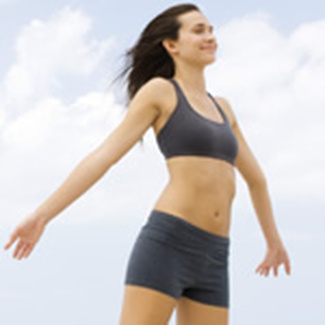
By Cathy Garrard
Prevention
You know exercise makes you feel good. Why not feel great? Harnessing—and maximizing—the restorative powers of your workout can send your mood soaring and get you psyched for tomorrow's session.Prevention pored over the research and consulted experts, including PhDs and even a hypnotist, to find easy, effective strategies to keep you revved long after you've unlaced your walking shoes.
Drink Caffeine
This stimulant doesn't just give you the energy to start your workout: New research suggests that it may help you feel better once you're done, too. Women who consumed the equivalent of 2 1/2 cups of coffee an hour before a 30-minute bike ride reduced leg muscle pain by nearly half, compared with those who didn't have caffeine, according to a study published in Medicine & Science in Sports & Exercise. Caffeine appears to work on the inflammatory agent known as adenosine.
"It may block the chemical from binding to brain or muscle receptors associated with pain," says lead researcher Robert Motl, Ph.D., an assistant professor of kinesiology and community health at the University of Illinois at Urbana-Champaign. Even just a cup of joe might add some oomph to your moves while easing pain.
Use Your Nose
Stimulating scents wake up your brain and body, suggests a study at Wheeling Jesuit University. Athletes who walked on a treadmill for 15 minutes while inhaling a peppermint aroma felt more invigorated afterward than those who walked without smelling anything.
"Peppermint increases brain activity in areas that heighten alertness," says lead researcher Bryan Raudenbush, Ph.D., an associate professor of psychology. The rejuvenating scent can also help enhance your workout so you experience that natural high faster. Although sniffing peppermint produces the best results, you can get a boost from flavored gums, mints, or a beverage such as Metromint water.
Another feel-good fragrance? Jasmine. Raudenbush says inhaling the sweet aroma after exercise helps your heart rate and blood pressure return to normal more quickly as you cool down, allowing your body to recuperate faster from a tough workout.
Prevention
You know exercise makes you feel good. Why not feel great? Harnessing—and maximizing—the restorative powers of your workout can send your mood soaring and get you psyched for tomorrow's session.Prevention pored over the research and consulted experts, including PhDs and even a hypnotist, to find easy, effective strategies to keep you revved long after you've unlaced your walking shoes.
Drink Caffeine
This stimulant doesn't just give you the energy to start your workout: New research suggests that it may help you feel better once you're done, too. Women who consumed the equivalent of 2 1/2 cups of coffee an hour before a 30-minute bike ride reduced leg muscle pain by nearly half, compared with those who didn't have caffeine, according to a study published in Medicine & Science in Sports & Exercise. Caffeine appears to work on the inflammatory agent known as adenosine.
"It may block the chemical from binding to brain or muscle receptors associated with pain," says lead researcher Robert Motl, Ph.D., an assistant professor of kinesiology and community health at the University of Illinois at Urbana-Champaign. Even just a cup of joe might add some oomph to your moves while easing pain.
Use Your Nose
Stimulating scents wake up your brain and body, suggests a study at Wheeling Jesuit University. Athletes who walked on a treadmill for 15 minutes while inhaling a peppermint aroma felt more invigorated afterward than those who walked without smelling anything.
"Peppermint increases brain activity in areas that heighten alertness," says lead researcher Bryan Raudenbush, Ph.D., an associate professor of psychology. The rejuvenating scent can also help enhance your workout so you experience that natural high faster. Although sniffing peppermint produces the best results, you can get a boost from flavored gums, mints, or a beverage such as Metromint water.
Another feel-good fragrance? Jasmine. Raudenbush says inhaling the sweet aroma after exercise helps your heart rate and blood pressure return to normal more quickly as you cool down, allowing your body to recuperate faster from a tough workout.
Breathe Deeply
Oxygen-rich blood keeps your heart, lungs, and muscles operating at optimal efficiency so you feel fired up—not drained—during and after exercise. A great way to maximize oxygen flow is with tai chi, a Chinese system of exercise that emphasizes deep breathing from the abdomen. "Focusing your breath this way enhances lung capacity, and the subsequent increase in oxygen boosts energy," says Ron Knaus, DO, author of A B Chi.
Try tai chi breathing between strength-training sets: Standing tall with feet hip-width apart and arms at sides, take a deep breath into your belly as you clench fists and raise both arms out to sides and over head. Relax hands, lightly touching thumbs and forefingers, and slowly exhale as you lower arms back to start. Repeat 10 times.
Take the Right Vitamins
Two-thirds of adult women don't get enough iron, an oversight that saps energy. We need this mineral to make hemoglobin, the red-blood-cell protein that carries oxygen throughout the body. "The deficiency is more common in active people because the body loses iron and other minerals through sweat," says Leslie Bonci, RD, director of sports nutrition at the University of Pittsburgh. Adult women need 18 mg of iron a day (8 mg after menopause). Get it from red meat (2 to 3 mg per 3-oz. serving of cooked lean beef), fortified cereals, or a multivitamin.
Low zinc levels can also leave you dragging. Exercisers who didn't meet their daily requirement had less-efficient heart rates and more trouble breathing during exercise, found a study in the American Journal of Clinical Nutrition. "Besides helping to make muscle, zinc regulates hormones that allow our bodies to access stored energy," says study author Henry Lukaski, PhD. Poultry and beans are good sources for getting the 8 mg you need a day.
Hydrate Early
"Dehydration depletes the body of the nourishment it needs to function at its peak," says Bonci. To boost performance, load up on liquids before you start sweating. "Sip 20 oz. of water an hour before exercise to give it time to circulate throughout your body," she says. To maintain good hydration during your workout, shoot for 14 oz. of fluid per hour if you don't sweat a lot, and 20 oz. per hour if you're the type who ends up dripping.
Picture Victory
Visualizing success while exercising can actually make your physical workout feel easier and more rewarding. Skyler Madison, a hypnotist and yoga instructor in New York City, recommends focusing on what you're achieving rather than letting your mind wander to your to-do list, which can trigger feelings of annoyance and stress. Playing a mental image in your head—seeing your goal weight on your scale or zipping up a pair of perfectly fitting jeans—enhances positive feelings.
Then, after your workout, sit or lie quietly and meditate on the good you've done for yourself and your body, the progress you're making toward your goals, and how proud you are of your accomplishments. No matter how tough the session you just completed, this practice teaches you to associate your workout with the afterglow of success. Just say aah.
A Brighter Workout
Some trainers swear that each color—part of the spectrum of light, or energy—can affect your workout. Experts are just now studying this one, but it can't hurt to slip on a bright sports tank. Red is thought to boost heart rate and energy, says Christina Leon, creator of the Colorgize fitness method, which incorporates color and lights into gym classes.
Outsmart Soreness
Even if you feel great after a workout, next-day soreness caused by inflammation from tiny tears in your muscles can still creep up. Exercise physiologist Declan Connolly, PhD, weighs in on how to avoid aches.
Oxygen-rich blood keeps your heart, lungs, and muscles operating at optimal efficiency so you feel fired up—not drained—during and after exercise. A great way to maximize oxygen flow is with tai chi, a Chinese system of exercise that emphasizes deep breathing from the abdomen. "Focusing your breath this way enhances lung capacity, and the subsequent increase in oxygen boosts energy," says Ron Knaus, DO, author of A B Chi.
Try tai chi breathing between strength-training sets: Standing tall with feet hip-width apart and arms at sides, take a deep breath into your belly as you clench fists and raise both arms out to sides and over head. Relax hands, lightly touching thumbs and forefingers, and slowly exhale as you lower arms back to start. Repeat 10 times.
Take the Right Vitamins
Two-thirds of adult women don't get enough iron, an oversight that saps energy. We need this mineral to make hemoglobin, the red-blood-cell protein that carries oxygen throughout the body. "The deficiency is more common in active people because the body loses iron and other minerals through sweat," says Leslie Bonci, RD, director of sports nutrition at the University of Pittsburgh. Adult women need 18 mg of iron a day (8 mg after menopause). Get it from red meat (2 to 3 mg per 3-oz. serving of cooked lean beef), fortified cereals, or a multivitamin.
Low zinc levels can also leave you dragging. Exercisers who didn't meet their daily requirement had less-efficient heart rates and more trouble breathing during exercise, found a study in the American Journal of Clinical Nutrition. "Besides helping to make muscle, zinc regulates hormones that allow our bodies to access stored energy," says study author Henry Lukaski, PhD. Poultry and beans are good sources for getting the 8 mg you need a day.
Hydrate Early
"Dehydration depletes the body of the nourishment it needs to function at its peak," says Bonci. To boost performance, load up on liquids before you start sweating. "Sip 20 oz. of water an hour before exercise to give it time to circulate throughout your body," she says. To maintain good hydration during your workout, shoot for 14 oz. of fluid per hour if you don't sweat a lot, and 20 oz. per hour if you're the type who ends up dripping.
Picture Victory
Visualizing success while exercising can actually make your physical workout feel easier and more rewarding. Skyler Madison, a hypnotist and yoga instructor in New York City, recommends focusing on what you're achieving rather than letting your mind wander to your to-do list, which can trigger feelings of annoyance and stress. Playing a mental image in your head—seeing your goal weight on your scale or zipping up a pair of perfectly fitting jeans—enhances positive feelings.
Then, after your workout, sit or lie quietly and meditate on the good you've done for yourself and your body, the progress you're making toward your goals, and how proud you are of your accomplishments. No matter how tough the session you just completed, this practice teaches you to associate your workout with the afterglow of success. Just say aah.
A Brighter Workout
Some trainers swear that each color—part of the spectrum of light, or energy—can affect your workout. Experts are just now studying this one, but it can't hurt to slip on a bright sports tank. Red is thought to boost heart rate and energy, says Christina Leon, creator of the Colorgize fitness method, which incorporates color and lights into gym classes.
Outsmart Soreness
Even if you feel great after a workout, next-day soreness caused by inflammation from tiny tears in your muscles can still creep up. Exercise physiologist Declan Connolly, PhD, weighs in on how to avoid aches.
- Start Slow: Warm up for eight to 10 minutes before each workout to gradually raise your heart rate and body temperature. "Warm muscles are more pliable, so you cause less damage," explains Connolly. To step up your routine without paying for it later, do six sessions at the same level before increasing intensity.
- Drink cherry juice: Tart cherries contain natural anti-inflammatories that help reduce pain and swelling. Exercisers in a University of Vermont study who drank 16 oz. of all-natural cherry juice for three days before strenuous exercise felt one-third less muscle soreness 2 days later.
- Ice it: Cold temperatures reduce swelling, which can minimize future pain. Connolly recommends icing joints for 15 minutes immediately following exercise.
 RSS Feed
RSS Feed







